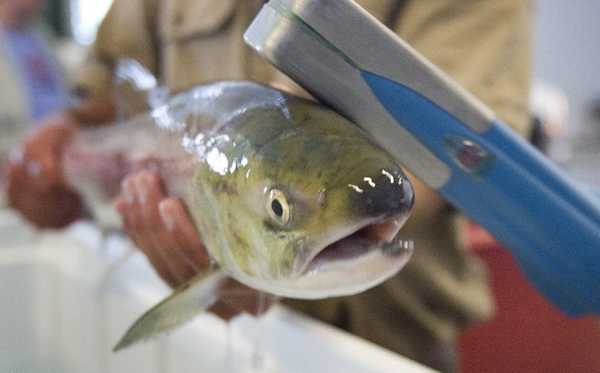forum
library
tutorial
contact

Several Theories Address
Sizes of Sockeye Salmon Runs
by Dennis Dauble, Special to the HeraldTri-City Herald, August 17, 2008
|
the film forum library tutorial contact |

|
Several Theories Address
by Dennis Dauble, Special to the Herald |
 The stars and planets often align in ways that resource managers do not fully understand.
The stars and planets often align in ways that resource managers do not fully understand.
Case in point: In a year full of negative surprises, Columbia Basin sockeye salmon exceeded expectations by long shot. The number of sockeye salmon that migrated over Bonneville Dam this summer was the highest in more than 50 years.
Although the Columbia River Basin produced more than 1 million sockeye salmon at the turn of the 19th century, they have been on life support for the past 20 years. On average, only two naturally-produced fish per year have returned to the upper Snake River.
The most famous male, "Lonely Larry," was captured so his sperm could be used to fertilize later generations. Subsequently, other returning adults have been trapped and used for a captive broodstock program at hatchery facilities managed by the Idaho Department of Fish and Game and the National Oceanic and Atmospheric Administration Fisheries Service.
It's primarily returning adults from these hatchery fish to Stanley Basin's Sawtooth Hatchery that bolstered this summer's runs to the Snake River.
Snake River runs pale in comparison to those in the upper Columbia River. More than 200,000 salmon swim toward major production areas such as Lake Wenatchee and Lake Osoyoos.
Interestingly, sockeye runs to traditional west-side sockeye salmon areas such as Lake Washington and Skagit River (Baker Lake) are predicted to be too low to support a sport fishery. The Yakima River once supported strong runs of sockeye salmon each summer. However, high water temperatures, irrigation practices and construction of storage reservoirs wiped them out in the early 1900s.
Sockeye salmon are considered the premium Pacific salmon in the supermarket because of their red meat, high oil content and rich flavor. These culinary traits are attributed to a diet rich in zooplankton, squid and small fish while in the ocean.
Long, finely-spaced gill rakers for straining small crustaceans from the water column make sockeye unusual. These feeding habits limit their lure-striking tendencies and frustrate anglers.
Sockeye salmon also are unique among Pacific salmon because they rely on lakes to complete their life cycle. While they spawn in lakes, beaches and river gravel, juveniles must rear in lakes before migrating to the ocean. It's a dependence that makes them more vulnerable to localized threats.
The first scientific studies of sockeye in the Columbia Basin did not occur until the late 19th century. Barton Evermann, an ichthyologist with the U.S. Fish Commission, reported finding large and a small forms of "redfish" in Lake Alturus, a high mountain lake of the Salmon River drainage.
Evermann considered these two forms to be different species. We now recognize the small redfish to be kokanee, or the landlocked form, and large redfish (those that migrate to the ocean and back) as adult sockeye salmon. Both forms are considered to be the same genus and species.
Sockeye salmon have a string of common names that correspond to their color. The landlocked and ocean versions are typically bright silver with deep bluish tinge on their back. Common names include "silvers" and "blueback."
They undergo a dramatic change on the spawning grounds -- more profound than any other species. Mature males develop a large hump, a grotesquely hooked snout and large canine teeth. Their body turns fire engine red and the head mallard green. Mature kokanee also exhibit secondary sexual characteristics at spawning time. Hence, the name "red" salmon.
Large swings in run size are a characteristic of sockeye salmon populations. In Bristol Bay, Alaska, and the Frazier River in Canada, runs are typically larger in even-numbered years vs. odd years. This pattern results in an "on" and "off" cycle that tends to persist because most sockeye return as 4-year-olds.
Other theories for the boom and bust nature of sockeye populations relate to harvest and to nutrient flow from decomposing carcasses. It's difficult to apply these theories to the Columbia Basin because recent runs have been so small.
Proponents of hatchery production and spill practices at Columbia River dams continue to toot horns over this year's success with sockeye salmon. However, given generally low returns for other salmon species, reasons for the sudden increase in "redfish" appear to be up for grabs.
One moral to the story may be to wait until all salmon are all in the river and counted before trying to predict the run size.
learn more on topics covered in the film
see the video
read the script
learn the songs
discussion forum
